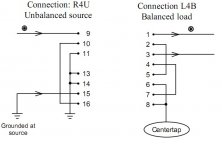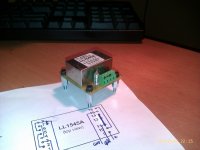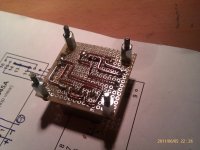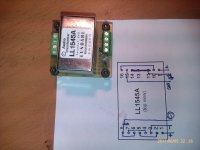Another question, this one may sound quite dumb; The Lundahl datasheet says that it accepts input signals up to +22dBU @ 40Hz.
One dBU equals 0.7746v, so if my calculations are correct, the maximum input signal would be around +100v?
I am assuming that 3+dB more is double the voltage, so 0dBU is 0.77v, 3dBu is 1.54...
Am I correct? Thanks,
regards
One dBU equals 0.7746v, so if my calculations are correct, the maximum input signal would be around +100v?
I am assuming that 3+dB more is double the voltage, so 0dBU is 0.77v, 3dBu is 1.54...
Am I correct? Thanks,
regards
I used the R4U/L4B connection, because it is 1:1 turns ratio and will give you 22dBU level.
For Dbu to Volt conversion, try this :
http://www.sengpielaudio.com/calculator-db-volt.htm
For Dbu to Volt conversion, try this :
http://www.sengpielaudio.com/calculator-db-volt.htm
no.Am I correct?
+3dB = double the power = sqrt(2) * V
+6dB = quadruple the power and double the voltage.
+10dB = 10times the power and ~3.16 * V
+20dB = 100times the power and ten times the voltage.
+22dBu ~= 10Vac
So if we use the transformer, we don't need the 10uf caps? Even if this is just PA150 and not BPA300?
Yes, a transformer can block DC. Also, it can convert balanced input to single end for use with PA150.
Yes, you can use the transformer for the end of just blocking DC. It will provide a high-pass and a low-pass filter, so RFI will be blocked too.So if we use the transformer, we don't need the 10uf caps? Even if this is just PA150 and not BPA300?
They are quite expensive though, around 60/70€ and you need one per channel. So maybe you'd be better going with a HQ capacitor.
Andrew,
Thanks once again for your amusing explanations, you seem to be always there to answer us who, just sometimes, refuse to read

Regards,
Regi
The balanced audio transformer does not "block" DC.
It does not transfer the DC from input to output.
The penalty for this is that the DC feeds a saturating current through the input winding and completely ruins the audio performance of the audio transformer.
It does not transfer the DC from input to output.
The penalty for this is that the DC feeds a saturating current through the input winding and completely ruins the audio performance of the audio transformer.
So even using a transformer, it is advisable to provide it with a dc-free input for higher performance.
I will think in placing a capacitor before the preamp, because these transformers are so picky that I am afraid of placing them between the preamp and the trafo.
The preamp I will use is an OPA627 with a BUF634 in its loop. There is a 50ohm resistor in series with the output, so output impedance is a bit above 50ohms.
Regards,
Regi
I will think in placing a capacitor before the preamp, because these transformers are so picky that I am afraid of placing them between the preamp and the trafo.
The preamp I will use is an OPA627 with a BUF634 in its loop. There is a 50ohm resistor in series with the output, so output impedance is a bit above 50ohms.
Regards,
Regi
or the DC must be exactly balanced to remove the DC emf across the input winding.So even using a transformer, it is advisable to provide it with a dc-free input for higher performance.
Hello,
I have already tested the LL1545A input tx but I have still one doubt. Attached is the connection I've used (R4U-L4B). May I assume that in the input side, where it says "Grounded at source", it refers to both pins 11-13-14 and 15, and not only pin 15?
Thanks!
Regards
I have already tested the LL1545A input tx but I have still one doubt. Attached is the connection I've used (R4U-L4B). May I assume that in the input side, where it says "Grounded at source", it refers to both pins 11-13-14 and 15, and not only pin 15?
Thanks!
Regards
Attachments
no.
It appears to me that the grounded at source PIN15 is the return of the signal flow.
PINs 11, 13 & 14 appear to be screens and such like and need to be connected to the main shield/chassis.
It appears to me that the grounded at source PIN15 is the return of the signal flow.
PINs 11, 13 & 14 appear to be screens and such like and need to be connected to the main shield/chassis.
That's a good explanation. I don't know why the manufacturer doesn't clearly state that implementation recommendation.
Thanks,
Regards
Thanks,
Regards
- Status
- Not open for further replies.
- Home
- Group Buys
- BPA300 mono block



